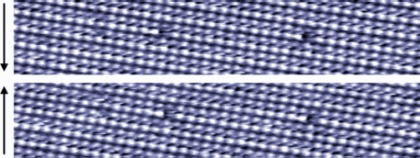May 2, 2011 — Asylum Research’s Cypher atomic force microscope (AFM) is routinely achieving resolution of atomic-scale point defects in liquid. While scanning tunneling microscopes have demonstrated point defect resolution since their invention, it has been more elusive in AFM. Many commercial AFMs can routinely image atomic lattices in ambient and liquid conditions, but the lack of point defects has led most researchers to conclude that the contact areas are typically several atoms across.
 |
|
Figure. Successive AC mode topography images of the cleavage plane of a calcite crystal in water. The repeated point defects demonstrate the true atomic resolution capabilities of the Cypher AFM. Arrows indicate scan direction. Scan size 20nm; Z scale 3.2Å; Cantilever Amplitude 4Å; Cantilever Frequency 454 kHz. |
More recently, instrumental improvements have brought true atomic resolution to ultra-high vacuum (UHV) AFM. Achieving true-atomic resolution under ambient conditions at the liquid-solid interface brings this resolution to an environment highly relevant for much practical research. The Cypher AFM’s signal-to-noise and support for ultra-small probes have enabled this breakthrough in atomic scale imaging.
Asylum Research took the most popular imaging mode, AC-mode (also known as tapping, intermittent-contact, or dynamic AFM) and improved the resolution, Jason Cleveland, Asylum Research CEO, said. It was achieved with improved signal-to-noise ratio from the use of ultra-small cantilevers with megahertz resonant frequencies in liquid; the optical lever detection noise floor was pushed to 25 fm/rtHz, allowing the measurements to remain thermally limited even with very stiff cantilevers and amplitudes as small as 1 Angstrom. Cypher’s low open-loop noise of 5pm in X, Y, and Z allows the stability to image at this scale, even on a scanner with a 30µm lateral range.
Asylum Research provides atomic force and scanning probe microscopy (AFM/SPM) for materials and bioscience applications. Asylum’s Cypher AFM is a small sample AFM/SPM providing low-drift closed loop atomic resolution. Learn more at www.AsylumResearch.com.
Follow Small Times on Twitter.com by clicking www.twitter.com/smalltimes. Or join our Facebook group

